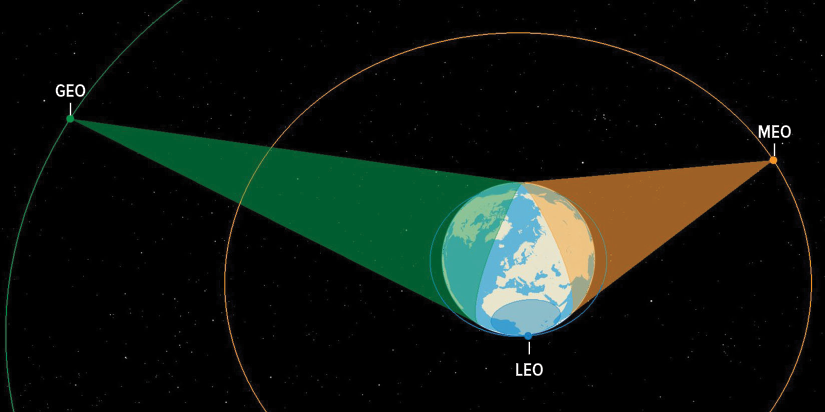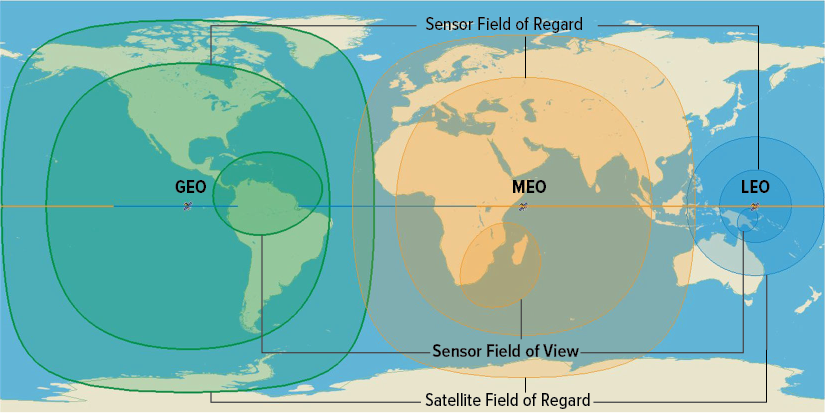An Overview of Low Earth Orbit (LEO) Satellites: An Emerging Technology for Connectivity and Innovation
Blog Post

marian/Getty Images
Oct. 30, 2025
Introduction
Since the launch of Sputnik I in 1957, satellite technology has grown dramatically to facilitate connectivity, including broadcast, cellular service, and broadband internet access. Recent advances in satellite technology through low earth orbit (LEO) satellites present an emerging opportunity to provide both individual and enterprise users—particularly those in underserved or hard-to-reach areas—with low-latency, high-speed connectivity. To leverage LEO satellites to advance connectivity, industry, civil society, and policymakers at all levels must work together to address several challenges facing LEO satellite development and adoption, including (1) promoting a sustainable competition environment; (2) facilitating LEO satellite market entry and coexistence with streamlined licensing frameworks and efficient spectrum sharing; and (3) integrating LEO satellites into existing and future digital access and inclusion programs.
A Brief Overview of Low Earth Orbit (LEO) Satellites
What Are LEO Satellites?
Satellite technologies are divided into three categories based on the orbital range they occupy: Geosynchronous Orbit (GEO), Medium Earth Orbit (MEO), and Low Earth Orbit (LEO). LEO satellites operate in the closest range to Earth, orbiting between 300 and 2,000 kilometers above the planet’s surface. At this altitude, latency (or lag time) is reduced, enabling LEO satellites to provide near-real-time communications with less signal power for transmission. This allows LEO satellites to be smaller in size than those in MEO or GEO, reducing the cost for development and deployment.
Field of Regard for Satellites in Various Orbits

This illustration represents a three-dimensional depiction of the viewing area (field of regard) of satellites in LEO (1,000 km), MEO (18,000 km), and GEO (35,786 km).
Source: Screenshot and caption from “Large Constellations of Low-Altitude Satellites: A Primer,” May 2023, Congressional Budget Office, cbo.gov/publication/59175.
While LEOs can provide enhanced satellite communication services due to their proximity to Earth’s surface, they do come with tradeoffs. In particular, LEOs have smaller coverage areas than MEOs and GEOs, and they must constantly be in motion in order to offset the pull of gravity and stay on their orbital path. Due to their proximity, movement, and small size, a “constellation” of hundreds or thousands of LEOs is typically needed to provide consistent service to an area. Additionally, LEO satellites, which complete an orbit approximately every 90 minutes, are fuel-intensive to operate and prone to atmospheric drag, which degrades satellites over time. As a result, a typical LEO satellite lifespan ranges from 7 to 10 years.
Fields of View and Fields of Regard for Sensors and Satellites in Various Orbits
If the viewing angle must be at least 20 degrees above the horizon, the sensor’s field of regard (intermediate circles) is smaller than the satellite’s field of regard (outer circles).
Source: Screenshot and caption from “Large Constellations of Low-Altitude Satellites: A Primer,” May 2023, Congressional Budget Office, cbo.gov/publication/59175
How Do LEO Satellites Work?
LEO satellite systems consist of three main components: the satellite constellation, user terminals, and ground stations. Since LEO satellites are in constant movement, user terminals and ground stations continually switch among different satellites within a constellation to maintain a user’s connectivity. While LEO satellites generally need to be within range of a ground station to send or receive data, satellites also use inter-satellite links to share data among themselves until the data reaches a satellite within range of a ground station. Advancements in intersatellite links, such as laser-based technologies, help LEOs provide reliable connectivity, even in areas far from a ground station.
Satellites use spectrum—radio frequencies that transmit wireless signals—to send (downlink) and receive (uplink) information from user terminals and ground stations. Since available spectrum is limited, it is regulated nationally and internationally to promote global harmonization and to avoid interference, or signal disruptions. The International Telecommunication Union (ITU), an organization within the United Nations that coordinates spectrum globally, has allocated specific frequency bands for satellite communications, including the L-, S-, C-, X-, Ku-, Ka-, and Q/V bands. Currently, the most commonly used bands for connectivity-oriented LEO satellites are Ku- (12-18 GHz) and Ka- (26.5-40 GHz) bands.
Advancing Connectivity Through LEO Systems
How Do LEO Satellites Compare to Existing Connectivity Methods?
Recent advances have lowered the cost of LEO satellite development and deployment, bringing greater attention to the technology as a connectivity solution. For rural, remote, and sparsely populated areas, fixed wireline connectivity may not be feasible or cost-effective. While fiber or other wireline connections provide reliable high-speed internet, building out the necessary infrastructure requires significant investment and often lengthy timelines. Other alternatives—including cellular service, dial-up internet, and GEO satellites—are likely to offer slower speeds, greater latency, and suffer more service disruptions. LEO satellites can offer comparatively low-latency, high-speed internet access without extensive infrastructure buildout, making them a promising solution for providing connectivity in hard-to-reach or high-cost areas.
However, given that this is an emerging technology with extraordinary fixed costs, only a few companies currently offer commercial broadband through LEO satellites—and those that do are charging consumers more for these services than existing wireline options. While service costs may decrease with scale and competition, affordability remains a serious concern. Similarly, it is unclear if LEO satellite internet providers will be able to consistently deliver competitive, quality services in all areas, especially as demand grows and systems experience heavier traffic. However, sinceLEO systems are global and continuously in motion, increasing capacity in a particular region is the same as adding capacity to the overall constellation. These kinds of tradeoffs concerning LEO satellite affordability, service quality, and capacity should all factor into its role in closing the digital divide.
LEO Satellite Use Cases
Whether LEO satellites provide an alternative or complementary service to traditional broadband methods, they are uniquely positioned to serve the needs of users in motion, areas where infrastructure is limited or damaged, and sectors with critical communication needs. For example, LEO satellites may be used in the following use cases:
- Vehicles and platforms in motion: In June 2022, the Federal Communications Commission (FCC) approved SpaceX’s Starlink and Kepler Communications for Earth Stations in Motion (moving or transportable ground terminals) allowing the use of LEO satellites to provide connectivity for vehicles in motion, including cars, trucks, ships, and planes.
- Remote and hard-to-reach areas: Areas that are unserved or underserved by existing broadband infrastructure are beginning to turn to LEO satellite service to meet user needs. For example, in September 2020, the remote Hoh Indian Reservation in Washington began using Starlink beta services to provide internet access to residents. In October 2024, the state of Maine unveiled a program to provide 9,000 free Starlink terminals to facilitate immediate internet access for users in unserved, hard-to-reach locations.
- Enterprise Internet of Things (IoT): LEO satellites can provide enterprise connectivity services, such as providing cellular backhaul to increase network coverage, enhance cloud storage, and support for edge computing. LEOs can also provide connectivity for wide-spread IoT devices and machine to machine communications, from asset tracking and remote monitoring, to delivery drones and robotics.
- Natural disaster response: LEO satellite connections are being used in combination with GEO satellites to respond to natural disasters, returning service to areas where existing infrastructure is damaged.
- Areas experiencing conflict: LEO satellites are also offering a way for areas experiencing conflict, such as Ukraine and Gaza, to access connectivity for critical services.
- Community services: LEO satellites are being piloted to fulfill community network needs, including those of schools and libraries.
In addition, the FCC’s 2024 decision to authorize “supplemental communication from space” allows LEO (and GEO) satellites to transmit direct-to-devices (D2D) on select mobile carrier spectrum bands without the need for a ground station. Starlink and T-Mobile have been authorized to provide this service, which is currently limited to texting. At the same time, LEO operators can use Mobile Satellite Service spectrum to transmit directly to mobile devices without an arrangement with terrestrial mobile carriers (and potentially in direct competition with them). The most high profile example is Apple’s partnership with Globalstar to transmit directly to iPhones, both in the U.S. and potentially on a global basis.
State of Play in an Emerging Field
Overview of LEO Satellite Competition Environment
As a relatively new and emerging field, only a small number of companies are actively operating or planning to launch LEO satellite systems, with SpaceX’s Starlink standing out as the clear frontrunner. In 2024, one estimate placed the total number of functioning satellites in space at more than 10,000, with around 60 percent belonging to Starlink. Already leading the market, Starlink originally planned to launch 12,000 satellites for its constellation, but later expanded the project to 42,000 satellites. Other companies – including Eulestat’s OneWeb (operating 630 satellites), Telesat (operating 198 satellites), Amazon’s Project Kuiper (planning a constellation of 3,000 satellites), and Iridium Communications (operating 80 satellites) – are racing to provide connectivity via LEO satellites.
At the same time, many countries—including the United States, United Kingdom, Australia, and Canada—are exploring opportunities to advance and invest in the commercial LEO sector. Others like Canada and the EU are developing and heavily investing in national LEO satellite systems. The Canadian government provided Telesat Lightspeed a $2.14 billion loan to develop and operate a LEO network advancing national connectivity and defense. In December 2024, the European Commission announced a contract to build a multi-orbital constellation of 290 satellites for its Infrastructure for Resilience Interconnectivity and Security by Satellite (IRIS²) project. In China, two mega-constellation projects—Guowang and Qianfan—have plans to launch 13,000 and 14,000 LEO satellites respectively. As the field of LEO satellite connectivity matures, the orbital range is expected to become increasingly crowded, limiting orbital and spectrum availability while increasing space traffic and debris.
Overview of LEO Satellite Regulatory Environment
Because spectrum is limited, the Radio Regulations international treaty is used to govern and coordinate satellite operations to prevent interference. At the international level, the ITU allocates bands of spectrum globally and coordinates the registration of satellite frequency assignments and associated orbital positions of satellites. Satellite operators obtain licenses for spectrum use from their national regulators, who are responsible for ensuring registered satellite operators follow international guidelines as well as any specific national regulations. Filing a registered satellite operator with the ITU is a multi-step process designed to identify and mitigate any potential conflicts between a planned system’s orbital characteristics, frequency bands, and intended service areas with an existing system. As such, once certain spectrum bands are in use, new entrants must design their systems around existing operators.
To deter early filers from “warehousing” spectrum, or reserving it for future use, satellite operators must deploy systems within seven years of the ITU receiving its request or their claim expires. For LEO satellites, operators are required to deploy 10 percent of a planned constellation within two years, 50 percent within five years, and total deployment within seven years to maintain their spectrum use. The Radio Regulations are regularly revised through the ITU’s World Radiocommunications Conference (WRC), which convenes every three or four years to meet emerging spectrum needs.
In the United States, the FCC is responsible for managing and licensing spectrum for commercial purposes, as well as non-commercial uses by local governments. The FCC must also authorize U.S. market access for operators licensed in another country. Meanwhile, the National Telecommunications and Information Administration (NTIA) manages federal government use of spectrum. While the U.S. Department of Defense had previously overseen space situational awareness and space traffic coordination, the Trump Administration issued a memorandum in 2018 that moved these responsibilities to the Department of Commerce. In 2024, the Commerce Department released the initial phase of its new satellite safety coordination system for spaceflight launches and orbital debris.
Key Considerations for Advancing LEO Satellite Solutions
LEO satellites have a clear potential to advance universal connectivity and innovation by providing service to areas whose needs are not met by current technologies. As regulators and policymakers look to advance LEO satellite development and adoption, three key areas emerge for future collaboration: (1) promoting a sustainable competition environment; (2) facilitating LEO satellite coexistence through updated licensing frameworks and coordinated spectrum sharing; and (3) integrating LEO satellites into digital equity and broadband access initiatives. By tackling these challenges policymakers can advance LEO satellite solutions to bridge connectivity gaps to bring more people and businesses online.
Related Resources
A Brief Overview of Low Earth Orbit (LEO) Satellites: LEO Primers
- Perspectives on LEO Satellites: Using Low Earth Satellites for Internet Access | Internet Society | November 2022 | Overview of LEO satellite functionality and use cases
- Large Constellations of Low-Altitude Satellites: A Primer | Congressional Budget Office | May 2023 | Overview of LEO satellite function and orbits
- Low Earth Orbit Satellites: Potential to Address the Broadband Digital Divide | Congressional Research Service | August 2021 | Report on the potential and challenges associated with using LEO satellites for broadband connectivity
- LEO, MEO or GEO? Diversifying orbits is not a one-size-fits-all mission (3-part series) | Space Command Operations | July 2023 | Explainer on different satellite categories and uses
- Should Satellite Broadband Be Included in Universal Service Subsidy Programs? | Journal of Law and Innovation | November 2023 | Overview of the benefits of making LEO systems eligible for USF participation
- Above Maine, Starlink Twinkles | OOKLA |December 2024 | A look at Starlink’s performance in Maine’s LEO connectivity program
- Regulation of NGSO Satellite Constellations | Digital Regulation Platform | March 2024 | Overview of LEOs, regulatory challenges, and current LEO use cases
- Competition in the Low-Earth-Orbit Satellite Industry | Truth on the Market | October 2023 | Outline of considerations and priorities for encouraging NGSO competition
- Spectrum Rights in Outer Space: Interference Management for Low Earth Orbit (LEO) Broadband Constellations | Journal of Information Policy | December 2024 | Summary of LEO spectrum use and regulatory environment, with overview of alternative models for spectrum sharing
- NGSO Fixed Satellite Service Spectrum Priority in the US | Payload | December 2024 | Review of spectrum sharing rules for LEOs under new FCC guidelines
